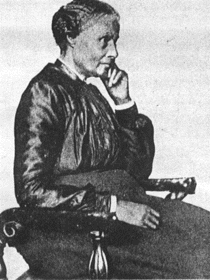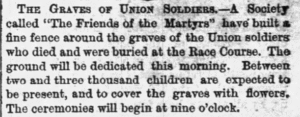Once upon a time in Black Entrepreneur History lived an African American woman named Mary Ellen Pleasant who became a wealthy entrepreneur, philanthropist and a woman who never regretted once all the work she put in for the freedom of her Black people as an abolitionist.
Born on August 20, 1814 in Augusta, Georgia (some census records say Philadelphia and others even say Massachusetts and this may be due to her using aliases), Mary Ellen Pleasant was the daughter of Mary L.P. Massie, a woman who was born in 1790 in Domigue, Haiti, and according to Mary Ellen Pleasant “a full blooded Louisiana Negress” who was enslaved and was also known as a voudun priestess. Her biological father was a white man whose name is believed to be Louis Alexander Williams. He released her from bondage of slavery when she was a child and paid for her schooling in Boston[1]. She did have stepfather named John Hampden Pleasants.
According to the 1880 census, both her parents were born in Virginia, however, all of this changes from census to census is possibly due to aliases she was known to have used.
She’d proved herself extremely intelligent in the city of Boston, but ended up on her way to California. Mary Ellen Pleasant became well known as a lavish cook and her name floated around the wealthy, and afterward she ended up helping a Scottish man named Thomas Bell gain a fortune of up to what equates to $30 million dollars today.
At this time she was married to James Smith, and they had a daughter named Emma. This was her first marriage, however, after he passed away in 1844, she was left widowed and with her daughter who passed away in 1855.
Her second marriage was to John James Plaissance (Pleasants). She was 40 years old and he was 39 at the time of the 1860 census. She was listed as a house servant. They both lived in San Fransisco, California, and she’d worked as a cook and servant with and for the man she helped gain all that money for – Thomas Bell.
Career
While Mary Ellen Pleasant worked for the Bell Family, she was placed in charge of a bachelor’s Boarding House at the death of Thomas Bell, she’d become the owner. Not only that, she ended up being the director of all of their wealth as well as the wealth of many other influential men in the area who frequented the Boarding House.
Mary Ellen Pleasant became a woman who knew how to overcome, fight for what she wanted and give to those in need. She manipulated the devises that she could and that she was born with – her looks. Being a biracial woman, she could pass for white when she needed to do so, and she needed to do so when she worked her day job as a “white proprietress” for wealthy white men. For this day work, she used her middle and 1st marriage name – Ellen Smith[3].
When she wasn’t working there, she invested all the money she earned and used it as a major person in the Underground Railroad. She used her real first name Mary and her last name Pleasants, and everyone knew she was Black[4].
As a matter of fact, after the signing and passing of the Emancipation Proclamation which made slavery illegal in the United States of America in 1863 that she officially tossed her white alias and declared herself “colored”, in other words, a Black woman.
By the 1870 census, she owned that bachelor’s Boarding House. It was like a gentleman’s club where they would entertain and even sleep. Her personal estate was listed as $15000, which is about half a million dollars in 2020 and her real estate was valued at the exact same amount. She was 50 years old and still married to her husband John Pleasant.
Mary Ellen Pleasant & the Bell Family Conspiracies & Fallacies/Rumors Against Her
There were many rumors that were actually printed up in papers to ruin her reputation – that she’d put a spell on the Bell family and took their money because they were under a “hypnotic spell”. It was rumored that she spent most of the money she took on “jewels” and the rest on feeding their neglected children with “stale buns and meat” that would have been given to chickens[5].
There was even a lie/rumor that accused Mary Ellen of shoving millionaire Bell to his death by knocking him over the bannister right after he deeded his mansion to her. “Knowing ones wagged their heads and pointed to the shrewd, spottlessly aproned Black woman, but no sphinx ever bore a stillier tongue than she.”[6]
Mary Ellen Pleasant was never arrested for murder. There was no proof that she did anything.
She was taken to court numerous times over decades allegedly stealing and tricking the money out of the Bells and other wealthy white people, however, there was never any proof. The media spun her life, calling it a “spider’s web” and so much lies and trickery that no conviction was ever obtained for all she was accused of doing.
All of this was false. There was no web.
Mary Ellen unfortunately fell into bankruptcy[7]. However, at Mary Ellen Pleasant’s death bed, she explained how they, the Bell family and other wealthy families, paid to have those rumors and lies printed about her to destroy her character and basically take all she had by keeping her in court for decades.
Philanthropy & Activism
Her work for the Underground Railroad was something to be cherished. She worked tirelessly for the rescue of the enslaved Black people escaping the South, and she also helped poor white women and children as well.
She along with other Negro organizations fought so that Black people would have a right to testify in courts, which was illegal for them at that point. She also fought against the extradition of the enslaved back to the South whenever slave owners would come to California to make money. She would rescue them and harbor them in the state because slavery was illegal in California.
As far as employment for Black people, she found approximately 70% of them work, making her the “biggest underground employment agent for poor women and Blacks in San Fransisco“.[8]
She also fought the law against the trolley system which wouldn’t allow Black people to ride the trolley. It was her fight against the system that ended in trolley system discrimination.
Mary Ellen in 1858, assisted abolitionist John Brown in the raid on Harper’s Ferry by collecting a fortune for the raid and even warned the enslaved of the raid before it happened. When the authorities arrived post raid, they found a note in John Brown’s person with her initials. Later in life before she died, she admitted that she assisted in the insurrection and those initials found on John Brown were hers – MEP.
“I never regretted what I did for my people and for the cause of freedom for my race.”
The Sacramento Bee (Sacramento, California) 12 Feb 1996, Mon Page 23
Finally but not all surely, she taught and provided shelter for women and prostitutes, both Black and white, even helping them strike common law agreements with the wealthy men, as well as gain child support. An example of this was in the case Sharon vs. Sharon.
Death
Mary Ellen Pleasant passed away at the age of 89 on 2751 Filbert Street and buried in Napa, California[9]. On her tombstone, she wanted it to read “She was a friend to John Brown”, however, it doesn’t read her wishes. Instead, it reads Mammy Pleasant, “Mammy” being a name she despised and preferred not to be called.
The public had began calling her that demeaning name during the Sharon vs. Sharon trial when she financially assisted a woman in her lawsuit against a California politician named Sharon to gain financial support and a divorce from their common law contract. The woman was suing her common law wealthy husband for $15 million.
Because Mary Ellen’s name was part of of the lawsuit due to her support of the woman, the public dragged her name as a woman who “engaged in baby selling” and prostitution.
According to a report from The Sacramento Bee of 1996, Mary Ellen stated, “They paid the newspapers to malign and vilify me and to blacken my character.” As far as the name Mammy, she stated, “They shan’t do it. They shan’t nickname me at my age.“
Sources
[1]The San Francisco Call San Francisco, California 12 Jan 1904, Tue • Page 16
[2,3,4,8]The Sacramento Bee (Sacramento, California) 12 Feb 1996, Mon Page 23
[5,6,7]San Francisco Chronicle (San Francisco, California) 19 Jan 1902, Sun Page 11
Year: 1860; Census Place: San Francisco District 10, San Francisco, California; Roll: M653_67; Page: 232; Family History Library Film: 803067
Year: 1870; Census Place: San Francisco Ward 4, San Francisco, California; Roll: M593_80; Page: 486B; Family History Library Film: 545579
Year: 1880; Census Place: San Francisco, San Francisco, California; Roll: 79; Page: 126A; Enumeration District: 205
Ancestry.com. U.S., Newspaper Extractions from the Northeast, 1704-1930 [database on-line]. Provo, UT, USA: Ancestry.com Operations, Inc., 2014.
Ancestry.com. U.S., Indexed County Land Ownership Maps, 1860-1918 [database on-line]. Provo, UT, USA: Ancestry.com Operations, Inc., 2010.
[9]Ancestry.com. California, U.S., County Birth, Marriage, and Death Records, 1849-1980 [database on-line]. Lehi, UT, USA: Ancestry.com Operations, Inc., 2017.
Photo: Public Domain with expired copyright, before 1925





More Related Stories
James Wormley – Founder of the Most Expensive Hotel in Washington D.C. in 1800s – the Wormley Hotel
William E. Matthews – Wealthy Financial Broker & Civil Rights Leader of 1800s
Charles Porter Grove – Owner of Montana and Illinois Gold Mining Company & Leader of the “Dreamed” Grove City, Montana